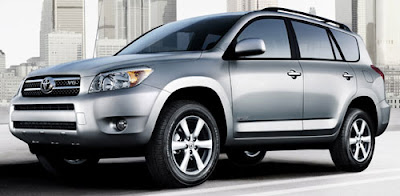
In a world where people are more comfortable when things are categorized, consider the thoughtfully engineered Toyota 2007 RAV4. It’s just the right size to get chores done around town, while rugged enough to have some outdoor fun. No matter how you put this Toyota RAV4 to use, its utility allows you to arrange the seats and ample storage space to accommodate any combination of passengers and packages. Its exterior is sleek and stylishly sculpted. Yet the RAV4 rolls like a true SUV with a powerful 4-cylinder engine or an available 269-hp V6. Exactly what kind of SUV is the 2007 RAV4? One that’s just too intelligent to be categorized.
Toyota Rav4 2007 Limited Edition
Mitsubishi Outlander 2007



The all-new Outlander SUV of Mitsubishi for 2007. Check it out...
Can I have one please?..
Ducati 1098
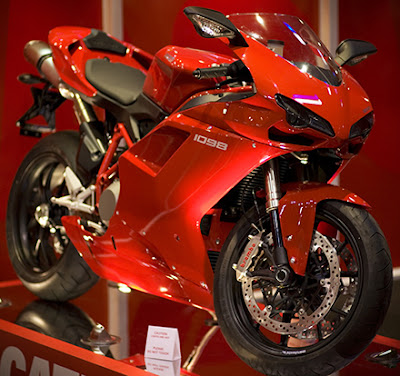
The Ducati 1098 is a 1099 cc L-twin sport bike manufactured by Ducati. It was announced on November 8, 2006 for the 2007 model year and replaces the 999. The 1098 makes a manufacturer claimed 160 horsepower, 90.4 ft-lb torque, and weighs 173kg. These figures gives the 1098 the highest torque-to-weight ratio of any production sport bike ever made. The 1098 shares more design elements with the older 998 than with its predecessor the 999, such as horizontally placed headlights and a non-integrated exhaust system. This step back to a more traditional Ducati design has been welcomed by many Ducati fans who criticized the design of the 999. MSRP of the base 1098 is US $14,995. The 1098 S is priced at $19,995 while the limited edition 1098 S Tricolore is $24,995.
2007 Ducati 1098 Ride Test
By Antonio Regidor, from Kyalami, Republic of South Africa
Published: December 24, 2006
Ducati has been trying to follow a very hard act since the introduction of the beautiful, iconic 916 superbike many years ago. That bike and chassis, with larger engine displacements in ensuing years, was responsible for many race track and sales successes. With the 999, Ducati tried a new direction in styling, and it was less successful with journalists and the public - the beautiful 916 had not been surpassed. The public expected more. Ducati, quite literally, went "back to the drawing board". The result is the 1098. With much more power and far less weight, on paper, the 1098 looks like it could be another landmark machine for Ducati. The styling is there for everyone to see . . . beautiful by almost all accounts.
The beautiful new 1098 can become a gold mine for the Bolognese brand, and inscribe in gold a new era. With curvy lines, minuscule tailpiece, double exhaust in the tailpiece, double headlights ripped with big inlets for Ram Air underneath, and an impressive single-sided swingarm it is a beauty to the eyes ... with the performance to match .
In South Africa, a country where gold and diamond mines are their greatest source of wealth, and more concretely on the South African circuit of Kyalami, we tested Ducati's white hope, the 1098, which Ducati intends to convert masses of sportbike enthusiasts to the Italian way. The mythical two-cylinder in L, taken to extreme. No wonder, next year there are plans to triple the sales currently generated by the 999...
Nevertheless, getting to the main point, as all Ducati's fans are waiting for an answer to the "million dollar" question: is the 1098 better than the 999? The answer is... an emphatic yes!
New Engine of Ducati 1098
Totally new, the 1,098 cc Testastretta Evoluzione is 5 kilos (12 pounds) lighter than the engine powering the 999. It revs quicker and higher; with a new sound that is more metallic, a sound that "sparks." Of more compact dimensions, because of its new heads and redesigned valves - similar to those of the Desmosedici -- it is truly better than the 999. In addition, its oval fuel injection nozzles - once again inspired by the Desmosedici - have allowed improved fueling, and that means more horsepower. By the way, since the Kyalami circuit is located at 1,800 meters (nearly 6,000 feet) above sea level, the declared 160 horsepower stayed at 140 due to the low atmospheric pressure... We will have to wait to be able to enjoy the full 160 horsepower.
The transmission is smooth and sure, and the clutch easier to use. Their mechanical noise level is also lower, therefore the 999 has been surpassed in all mechanical aspects.
Traction Control of Ducati 1098
Under a hot sun and above 32 C degrees of temperature - in the southern hemisphere it is summer now - we got ready to test the mythologized 1098. Just by turning the key, we would enjoy its 100% digital rectangular dashboard, with ten selectable functions from a double switch in the left handle - among those is a lap timer, lap time display screen, USB starter key of the Ducati Data Analyzer (DDA), battery and system error detection... By the way, on some of the screens on the 1098 - a few - appeared a ghost function called DTC and no one from Ducati dared to explain it. Nevertheless, we determined it is about the future traction control system that Ducati is testing. The Ducati Traction Control will soon be available in future versions of the 1098 - including the R version, and it will be able to be adjusted to each rider's pleasure from the digital dashboard and button control on the left handle.
Enough with the chatter. Let's ride. Hit the starter switch -- an exciting sound. Select first gear and take to the track. We had to learn Kyalami's layout, which is an unruly circuit, with ascents, slopes, a very sharp chicane, heavy braking zones, and all kinds of curves. An old school circuit that reminded me of the one at Eastern Creek in Australia, but much more beautiful, better cared for, although with some runoff areas not too appropriate for motorbikes. Luckily, the new SBK champion of the world, Troy Bayliss, came to show us the track, and took three laps with each group in the first session.
The 1098 surprised us from the first curve; it is much more manageable than the 999, it feels lighter, and the motor has enviable features. As soon as we begin to run hard, we can appreciate that the front brake system is just perfect, powerful and proportional. The new Monoblock radial Brembo calipers, with the 330 mm discs, are magnificent, without adding a gram to the brakes found on the 999. We will see if on the street they are not too abrupt, but on the track they were fantastic.
When turning, the motorcycle feels better, thanks to the lower weight of the Marchesini wheels, with lower gyroscopic effect. Nevertheless, if you have to flop the bike from one side to the other quickly, it is still necessary to work a little - with a distance of 1,430 mm between the axles, it has a wheelbase 10 mm longer than the 999.
Comfort of Ducati 1098
The riding position is now more natural, with the handlebars slightly higher and seat slightly lower. In this, it is much better than the 999. The gas tank is also slightly wider at knee level, but it is still narrower than a conventional motorcycle (an inline 4). This helps go through curves very smoothly, intuitively, aided by its powerful and smooth engine, which vibrates very little. It is the best twin-cylinder Ducati superbike ever, no doubt.
Other ergonomic details are that the windshield is low, and it is necessary to stoop to get protection, the riding position does not tire the wrists, the seat is well padded (for a Ducati superbike) and the footrests are well positioned. The digital tachometer is difficult to read at speed, so you end up relying on the four luminous warning lights of over rev in order to change gears - three warnings and the last when cutting ignition. The rider's working area is roomy and he can move slightly back even if he is more than 6 foot in height to be under the windshield, or to move from side to side.
The Pirelli Supercorsa Pro tires also performed well. With plenty of grip, they endured the abuse of the journalists without complaint. The rear tire is an unusual 190/55, 50 profile tires are normal.
Adjustments of Ducati 1098
First, the fork settings were troublesome. The bike would dive excessively under braking, and even lift the rear wheel in some of the heavier braking zones. With more spring preload dialed in, together with three additional clicks of compression damping in the fork, the bike was perfect. The bike was balanced whether accelerating hard or braking hard (very hard with these brakes). The bike was on rails in the corners absorbing bumps while on its side without any drama.
We also had a chance to test an S version, which had 10 additional horsepower. The stock Ohlins suspension swallowed everything. We ran even quicker laps on this model, as we played with the motorcycle's lap timer device, a device that allowed us to download information to our PC and analyze later.
Both models feature stock steering dampers -- an Ohlins model for the S version. These dampers never really made themselves known while testing . . . apparently doing their job perfectly.
The truth is that the 1098 has everything. It is beautiful, recaptures the essence of the 916 with its design and its single-sided swingarm, and it is much more effective than the 999. The engine is much more powerful and smoother. The motorcycle has more features, and the brakes are the best.
What we liked with Ducati 1098 -
Its stability, powerful and smooth engine, its powerful brakes, its aesthetics and finish are top quality. DDA is an extra toy.
What we didn't like -
The digital tachometer is hard to read. The windshield is very low. The brakes on the road may be too powerful.
Ducati 996
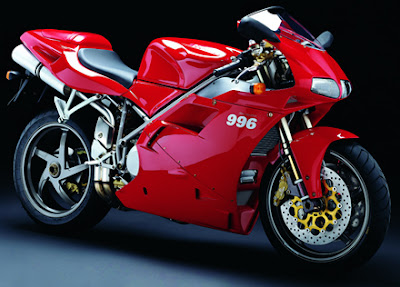
The Ducati 996 is an Italian street motorcycle manufactured by Ducati from 1999 to 2003. It was based upon the earlier 916. It competed against Honda's Fireblade, Suzuki's TL1000R and Aprilia's RSV Mille.
A black Ducati 996 is driven by Trinity during the famous freeway scene in the film The Matrix Reloaded (2003).
Versions of Ducati 996
From 1999, there were three different models of the 996: a base, or Biposto; the 996S with Öhlins suspension and the engine of the 996SPS and finally the 996R which was the second best in the 996 line which featured a new 996 cc engine.
Improvements of Ducati 996
The 996 had larger 98 mm (3.9in) pistons, larger valves, a stronger crankshaft and crankcases ported from the 916 SPS. But since the 916 camshaft gave a softer, less peaky power delivery and less top-end power: 83.5 kW (112 bhp) as against the SPS's 92.4 kW (124 bhp) the 996 was built with a new air intake system with two fuel injectors instead per cylinder. A new airbox and a distinctive underseat exhaust system were also built into the new design.
Ducati 996 Bike
The chassis was also modified but in a much more discreet way - the 916's handling was already well-regarded. Lighter wheels were introduced along with improved calipers, discs and pads stronger compared to the 916. The suspension system was still the same Showa design but both the front and back were fully adjustable for damping and preload.
Updates of Ducati 996
Updates in 2000 saw the wheels change and get updated to all new Marchesini wheels. The front forks were also titanium nitrided to reduce stiction. The spokes also changed from the three-spoke rim style of the 916 to a new five-spoke scheme. In 2001 another overhaul saw the 996 rear shock finally change from a Showa to an Öhlins increasing the 996's capability even more.
Range topper: Ducati 996 SPS
The 996SPS suffix stood for 'Sport Production Special'. The engine was the same as the one used in the 916SPS but the weight was cut down considerably. The 996SPS produced around 92.4 kW (124 bhp), more than the standard 996. The 996's special SPS engine was much stronger than anything that Ducati or any other manufacturer at the time had produced for the track. To ensure a distance was held between the standard 996 and the 996SPS Ducati designed a much higher specification chassis for the SPS. The wheels were a five spoke design but were lighter than the standard three spoke design of the 916 and the early 996. In 1999 the rear shocks were made by high quality Swedish suspensions manufacturer, Öhlins with Showa front forks. In 2000 Öhlins forks were added. The adjustable steering head also allowed geometry changes to the steel tube trellis frame making it suitable for different riding styles or race tracks.
Final updates of Ducati 996 SPS
As the 996SPS became a hot commodity, Ducati updated the bike with more advanced chassis parts to make it stay competitive. Most notably the Öhlins front forks featured a titanium nitride coating on the stanchions to minimise stiction. An aluminum rear subframe and other detail modifications reduced the bikes weight even further.
Specifactions of Ducati 996 SPS
- Engine: Liquid cooled, four stroke, 90° "L" twin cylinder, DOHC, desmodromic 4 valve per cylinder.
- Capacity: 996 cc
- Bore x Stroke: 98 x 66 mm
- Compression Ratio: 9.2:1
- Induction: Marelli electronic injection
- Ignition / Starting:- / electric
- Max Power: 123 hp 90 kW @ 9500 rpm (claimed at crankshaft)
- Max Torque: 99 Nm 10.1 kg-m @ 7000 rpm (claimed at crankshaft)
- Transmission / Drive: 6 Speed / chain
- Front Suspension: Öhlins with TiN upside-down fork fully adjustable. 127 mm front wheel travel
- Rear Suspension: Öhlins progressive cantilever linkage with adjustable monoshock. 130 mm rear wheel travel.
- Front Brakes: 2x 320 mm discs 4 piston calipers
- Rear Brakes: Single 220 disc 2 piston caliper
- Front Tyre: 120/70 ZR17
- Rear Tyre: 190/50 ZR17
- Dry-Weight / Wet-weight: 189 kg / 212 kg
- Fuel Capacity (res): 17 litres (4L)
- Consumption average: 16.4 km/lit
- Standing quarter Mile: 10.5 sec
- Top Speed: 280.8 km/h
Lamborghini Gallardo VS Ducati 999 Video
Lamborghini Gallardo VS Ducati 999
Two great Italian monsters in a battle!
2005 Ducati Supersport 1000DS

After more than three decades of design development, the Ducati Supersport is considered an icon in the modern motorcycling world with a reputation for great handling, smooth power delivery, versatility and light weight. For 2005, the Ducati Supersport 1000 carries the family heritage proudly into the future while adhering to and improving on the time-tested formula of its predecessors.
Confidence-inspiring and built with quality throughout, the Supersport models are a great way to enter the world of Ducati sport motorcycles. The air-cooled engine expresses the essential practical and pragmatic Ducati philosophy and has significant design and application advantages.
A bike that's fun to ride, beautiful to look at, and easy to maintain.
Features and Benefits of Ducati Supersport 1000DS
Supersport 1000 DS: Easy to handle but high in performance, it sports a powerful 992 cc Dual Spark fuel-injected Desmo engine, an advanced trellis frame, and superior suspension to ensure top of the line performance and handling. Confidence-inspiring and built with quality throughout, the Supersport models are a great way to enter the world of Ducati sport motorcycles.
In all, the 1000 DS is the most advanced air-cooled Ducati Desmo engine ever designed.
Engine / Drivetrain of Ducati Supersport 1000DS
- Type L-twin cylinder, 2 valves per cylinder Desmodromic; air cooled
- Displacement 992 cc
- BorexStroke 94 x 71.5 mm
- Compression Ratio 10:1
- Power 69.9 kw - 95 hp @ 7750 rpm
- Torque 9.7 kgm @ 5750 rpm
- Fuel injection Marelli electronic fuel injection, 45 mm throttle body
- Exhaust 2 aluminum mufflers with 3-way catalytic converter (non-catalytic on USA version)
- Emissions Euro2 (except USA version)
Transmission of Ducati Supersport 1000DS
- Gearbox 6 speed
- Ratios 1st 37/15, 2nd 30/17, 3rd 27/20, 4th 24/22, 5th 23/24, 6th 24/28
- Primary drive Straight cut gears; ratio 1.84
- Final drive Chain; Front sprocket 15; Rear sprocket 38
- Clutch Dry multi plate with hydraulic control
Chassis/Suspension of Ducati Supersport 1000DS
- Frame Tubular steel trellis
- Wheelbase 1395 mm / 54.9 in
- Rake 24°
- Front suspension Showa 43 mm upside-down fully adjustable lightweight fork
- Front wheel travel 120 mm / 4.7 in
- Front brake 2 x 320 mm semi-floating discs, fixed 4-piston caliper
- Front wheel 5-spoke light alloy 3.50 x 17
- Front tyre 120/70 ZR 17
- Rear suspension Progressive cantilever linkage with fully adjustable Öhlins mono shock with length adjustment. Aluminum swing arm
- Rear wheel travel 145 mm / 5.7 in
- Rear brake 245 mm disc, 2-piston caliper
- Rear wheel 5-spoke light alloy 5.50 x 17
- Rear tyre 180/55 ZR 17
- Fuel tank capacity 16 L / 4.2 US gal (includes 4 L / 1 US gal reserve)
- Weight * 179.4 kg / 396 lbs
- Seat height 820 mm / 32.3 in
- Instruments Electronic panel: speedometer, rev counter, high beam indicator, turn signals, oil pressure warning light, neutral light, low fuel warning light, immobilizer system, LCD for clock and oil temperature, LCD odometer and trip meter
- Warranty 2 years unlimited mileage
- Tank Colours Red, yellow, metallic dark grey
- Frame and Wheel colours Metallic dark grey
- Versions Two seats
* = The weight includes battery, lubricants and, where applicable, cooling liquid.
Additional Features of Ducati Supersport 1000DS
New for 2004 The Supersport remains a reference point in the world of Ducati dedicated to motorcyclists who seek the thrills of sports riding from a truly thoroughbred, agile machine. The Supersport's strong links with the past have certainly not held back its development. Over the years the bike has become a perfect synthesis in design, combining the looks and riding style of yesteryear with the most modern, flexible two valve engine in the entire Ducati range.
Accessories of Ducati Supersport 1000DS
If that's not enough, you can personalize the Supersport to your own specifications by choosing from the many items available in the Ducati Performance accessories catalogue.
Peg Perego Ducati Monster
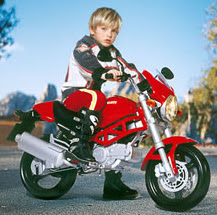 Start them young, plant the seed in their mind and let it grow. That seems to be Ducati's idea with this little child's version of a Ducati Monster. Instead of little electric cars or trucks, why not start them right with a motorcycle?
Start them young, plant the seed in their mind and let it grow. That seems to be Ducati's idea with this little child's version of a Ducati Monster. Instead of little electric cars or trucks, why not start them right with a motorcycle?
Ducati Press Release:
The "street fighter" for children aged 3 and up.
Peg Perego, in close cooperation with Ducati, has reproduced a faithful scale model of one of Ducati's most successful motorcycles, the Ducati Monster.
Here are some of the carefully studied details of the Peg Perego Ducati Monster:
- The new Monster is powered by a 12-Volt, 8-Ah rechargeable battery which ensures 1 hour play
- Peg Perego has a maximum speed of 7.5 km/h;
- Peg Perego Ducati includes battery and battery charger;
- It is equipped with stabilisers that can be removed when the child has become familiar with the motorcycle and has acquired a sense of balance;
- Ducati Peg Perego features an accelerator handle and pedal brake;
- Peg Perego motorcycle is suitable for all terrains, including bumpy ground, and can climb a 10% slope;
- This Ducati Monster is suitable for use in private places (not in public areas devoted to the circulation of pedestrians, vehicles and animals) and complies with Directive 88/378/EC on toy safety, approved by a European Quality Certification Institute.
The Peg Perego Ducati Monster is the perfect way for kids, from 3 - 8 years old, to enter the world of motorcycling. This mini Monster will give your child an authentic sports motorcycling experience, thanks to care in reproducing the details of the original Ducati Monster: rear-view mirrors, horn, headlights and even the well-known roar of the Ducati engine.
Ducati Desmosedici RR
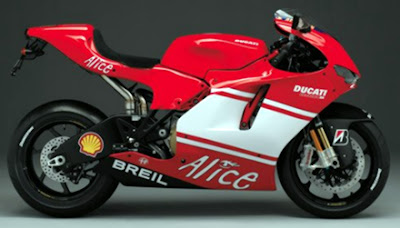
Ducati introduced details of its Desmosedici RR production machine -- a machine based closely on the MotoGP weapon campaigned by Ducati. Simply put, Ducati claims this will be the highest performance production motorcycle available. Expect it to go on sale in July, 2007. You can reserve your Desmosedici RR at your Ducati dealer now (if you have plenty of disposable income).
Ducati chose the occasion of this weekend's Mugello GP for the introduction of the Desmosedici RR. Production will be limited to approximately 400 bikes per year. Here is some of what Ducati had to say about the new bike, including the spec sheet (at the bottom):
Engine of Ducati Desmosedici RR
The Ducati Desmosedici RR features advanced technology and aerodynamics that are derived from the GP6 currently being raced in the 2006 MotoGP World Championship.
The engine of the Desmosedici RR accurately reflects that of the MotoGP bike: Ducati's traditional desmodromic distribution, guaranteeing precise valve control up to the highest revs, is perfectly matched to the 989 cc four-cylinder 'L' layout, with four titanium valves per cylinder, in asymmetrical Twin Pulse configuration, producing a masterwork of precision engineering.
The double overhead cams are gear driven, a sophisticated and reliable solution that enables precise valve timing in all conditions. This authentic copy of the Grand Prix engine is completed by a six-speed transmission, which retains its 'racing' characteristic by being cassette type, and a hydraulically actuated dry multi-plate slipper clutch.
The aim of producing a light but robust engine has led not only to an unrivalled quality component design but also the use of exclusive racing-derived materials: sand-cast, aluminium crankcase and cylinder heads, titanium connecting rods and valves, sand-cast magnesium engine covers.
Four 50 mm Magneti Marelli throttle bodies are present, with 12-hole 'microjet' injectors. For sophisticated management of the powerful four-cylinder engine a Magneti Marelli 5SM ECU and high-speed CAN line electronics have been used.
An all-time 'first' comes with the use of a '4 into 2 into 1' exhaust, with "vertical exit" silencer, hidden in the tail cover.
These are all benchmark performance features for a MotoGP replica bike, which is capable of delivering more than 200 hp of power with the 102 dB racing silencer and dedicated CPU race kit.
Amazingly the Desmosedici RR with its catalytic oxygen sensor exhaust, homologated for road use, fully complies with Euro3 emissions regulations.
Chassis of Ducati Desmosedici RR
The engine clearly represents the beating heart of this fantastic motorcycle, but the technological advancements also extend to the chassis: a signature tubular trellis hybrid frame, refined components, and a superb carbon fibre body. This is a motorcycle that is destined for an expert rider, someone who is always looking for extreme sporting performance, as well as being an exclusive, esoteric, reliable product that is more than capable of track racing.
The colour scheme of the Desmosedici RR was the work of Alan Jenkins, the designer and one of the men behind the Desmosedici MotoGP, who was also responsible for the aerodynamics package which is aimed at achieving maximum speed and excellent handling. The bike is totally inspired by the racing machine, the Ducati Desmosedici GP6, from which it inherits all the aggressiveness of its lines. It is fitted with a new lightweight multifunction dashboard, developed in collaboration with Ducati Corse, the same one that will be fitted to next year's racing machine, the Desmosedici GP7.
The bike's development could not have been made possible without the significant collaboration of Vittoriano Guareschi, the official Ducati Corse tester, whose riding abilities and hundreds of hours of track time have made a fundamental contribution to the evolution of the project.
For the first time the Ducati Desmosedici RR uses a new welded tubular steel trellis hybrid frame (ALS 450) with the frame geometry that is the same as that of the Desmosedici GP6.
This construction guarantees an excellent stiffness to weight ratio, allowing superior manoevrability and riding precision. Attached to the red frame is the rear seat support in high temperature resin type carbon fibre. This material, normally used only on racing bikes, has the characteristic of being extremely lightweight but exceptionally rigid.
The Desmosedici RR sports a new extra-long, cast, forged and pressed aluminium alloy swingarm. The geometry and the technology of this component derive directly from the MotoGP bike, and give the RR a high level of traction control, and excellent weight distribution as well as a superb stiffness to weight ratio.
In the suspension department the Ducati Desmosedici RR features the most advanced technical components.
The rear suspension geometry and layout is the same as that of the GP6, with the rear shock attached above the swingarm and to a rocker, which is hinged to the crankcase.
The front suspension features 43 mm upside-down Öhlins FG353 pressurized forks (PFF), with TiN coated sliders. The forks, which come directly from competition use, as well as being pressurized thus ensuring excellent track performance, are fully adjustable in preload, rebound and compression.
The rear shock is also Öhlins and has rebound, low/high speed compression adjustment and hydraulic preload adjustment.
For the first time ever, this Ducati production motorcycle features Marchesini forged and machined magnesium alloy wheels, with 7 spoke design as on the GP6. This helps to reduce unsprung weight and inertia, all the while improving handling and suspension response.
With the aim of producing the ultimate track performance, Ducati in collaboration with Bridgestone is developing special tyres for the Desmosedici RR. The tread pattern, construction and profile are being specially developed and produced by the Japanese tyre manufacturer.
The numerous racing components of this high-performance machine also include its Brembo brakes. Up front the Desmosedici RR features a new pair of radial 'monoblock' callipers with four 34 mm pistons: monoblock technology, until now only used for racing callipers, allows calliper stiffness to be increased, thus improving braking response; the front brake system is completed by a radial master cylinder, with hinged lever and remote 'quick' adjuster. The pair of front brake discs are the same as those used on the GP6 in its wet weather race set-up: two semi-floating 320 mm x 6 mm discs, with machined flange. The Brembo rear brakes are made up of a 240 mm fixed disc and a floating calliper with two 34 mm pistons.
The Desmosedici RR will be available with a special race kit that includes a 102 dB racing exhaust, a dedicated CPU, bike cover, paddock stand.
For this exclusive Ducati, a new dedicated service plan is included.
Each Ducati Desmosedici RR owner can benefit with a three-year warranty and three years of scheduled maintenance, free of charge.
Two versions of the RR will be available:
- the Desmosedici RR - painted in 'Rosso GP', with a white number plate on the tail section;
- the Desmosedici RR 'Team Version' - painted in 'Rosso GP', and as with the factory Corse bikes, has a broad white stripe on the fairing.
A team sponsor decal kit will be provided with each bike.
Technical Specifications of Ducati Desmosedici RR
Engine of Ducati Desmosedici RR
Type: L-4 cylinder, liquid-cooled, DOHC, Desmodromic, 4 valves per cylinder, gear driven camshafts
Displacement: 989 cc
Power: More than 200 HP @ 13,500 rpm*
Torque: n/a
Fuel injection: Four 50 mm Magneti Marelli throttle bodies, 12-hole "microjet" with injectors over throttle, manual idle control;
Exhaust: '4 into 2 into 1'vertical exit exhaust/silencer
Emissions: Euro 3
Trasmission of Ducati Desmosedici RR
Gearbox: 6-speed; Cassette type
Clutch: Dry multi-plate slipper clutch, hydraulically actuated
Vehicle of Ducati Desmosedici RR
Body: Full carbon fibre bodywork
Frame: Tubular steel trellis hybrid, carbon fibre seat support, aluminium swingarm
Front Suspension: Ohlins 'FG353' PFF forks USD 43 mm pressurized, with preload, rebound and compression adjustment, TiN coated sliders
Front Wheel: Marchesini forged and machined magnesium alloy wheels, with 7 spoke design as GP6
Rear Suspension: Ohlins rear shock, with rebound, low/high speed compression adjustment, and hydraulic preload adjustment
Rear Wheel: Marchesini forged and machined magnesium alloy wheels, with 7 spoke design as GP6
Tyres: Bridgestone
Front Brake: Two Brembo radial "monoblock" callipers with four 34 mm pistons; two semi-floating 320 mm x 6 mm discs, with machined flange: the same as GP6 wet race set-up
Rear Brake: 240 mm fixed disc, floating calliper with two 34 mm pistons
Fuel tank: aluminium alloy
Dry Weight: n/a
Instruments: New lightweight Corse electronic multifunction dashboard with LCD 'bar' graph tachometer, trip/odometer, anti-theft immobilizer, lap time measurement, oil pressure, fuel reserve, EOBD, clock, air temperature, rev counter.
Version of Ducati Desmosedici RR
Versions: Single-seat
Version of Colours:
- Desmosedici RR: Rosso GP with a white number plate on the tail section;
- Desmosedici RR "Team Version": Rosso GP with broad white fairing stripe. A team sponsor decal kit will be provided with each bike.
* With racing exhaust (102 dB) - without catalytic converter